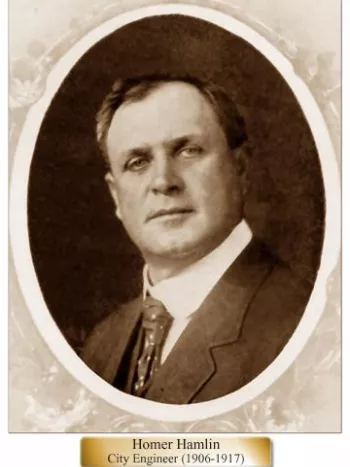
Homer Hamlin was born on August 27, 1864 in Pine Island, Minnesota. He attended public schools of the state, taught country school, and had one year of college at Rochester, Minnesota.
At twenty two years of age, he moved to San Diego, California, where, after some time spent in the city engineering department, he was employed by various private engineering enterprises.
In 1894, Mr. Hamlin returned to Los Angeles and spent the next seven years in the departments of the County Surveyor and the City Engineer.
January 1899, he was appointed Chief Deputy of Field Forces, City Engineer, and served the following three years. Upon leaving this position in 1901, Mr. Hamlin joined the United States Reclamation Service where he was engineer for the Yuma project during the construction of the Laguna Dam across the Colorado River.
In August of 1906, Mr. Hamlin was appointed City Engineer of Los Angeles, and served in this office to July 1917. During his terms as City Engineer, he completed the Outfall Sewer, a series of tunnels in water bearing formation which had been abandoned as unfeasible by previous contractors. He served on the Aqueduct, and supervised notable engineering and construction works of this locality. Among these were professional services on the Los Angeles Harbor, the Hill Street Tunnel, and the adoption of the Trilby rail under his technical advice.
In 1909, Mr. Hamlin actively campaigned for acquisition of a strip of land known as the Shoe String, connecting Los Angeles with San Pedro and Wilmington.
Upon leaving the office of City Engineer, Mr. Hamlin engaged in private practice of his profession of civil and consulting Engineer.
Homer Hamlin was largely a self-educated engineer. Studiously disposed, he made extensive and specialized researches in geology, and technical phases of his profession. His report on the Salinas Valley water resources was one of his important geological studies. At one time, Mr. Hamlin was identified with the development of Southern California oil fields.
A few months prior to his death, he made an expedition down the Colorado River to Yuma, Arizona to study the possibilities of the great storage enterprise at the lower end of the Grand Canyon at Boulder Canyon. While a delegate of the Association of Water Users of the Salt River Valley, in connection with the Salt River Irrigation Project, Mr. Hamlin died on May 14, 1920 in Washington, D.C.
During his tenure as City Engineer, motion picture production began in Hollywood. The first municipal wharf at Port Los Angeles was completed.
Sources:
Personal Interview with widow, Carrie D. Hamlin in 1936; (R92, H223, UF), Municipal Reference Library.
Chronological Record of City Offices, 1850-1938, Municipal Reference Library.